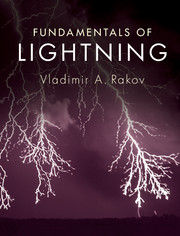Book contents
- Frontmatter
- Dedication
- Contents
- Preface
- 1 Types of lightning discharges and lightning terminology
- 2 Incidence of lightning to areas and structures
- 3 Electrical structure of thunderclouds
- 4 Properties of the downward negative lightning discharge to ground
- 5 Calculation of lightning electromagnetic fields
- 6 Modeling of the lightning return stroke
- 7 Measurement of lightning electric and magnetic fields
- 8 Electromagnetic methods of lightning location
- 9 Lightning damaging effects and protective techniques
- Appendices
- References
- Index
6 - Modeling of the lightning return stroke
Published online by Cambridge University Press: 05 April 2016
- Frontmatter
- Dedication
- Contents
- Preface
- 1 Types of lightning discharges and lightning terminology
- 2 Incidence of lightning to areas and structures
- 3 Electrical structure of thunderclouds
- 4 Properties of the downward negative lightning discharge to ground
- 5 Calculation of lightning electromagnetic fields
- 6 Modeling of the lightning return stroke
- 7 Measurement of lightning electric and magnetic fields
- 8 Electromagnetic methods of lightning location
- 9 Lightning damaging effects and protective techniques
- Appendices
- References
- Index
Summary
Introduction and classification of models
Any lightning model is a mathematical construct designed to reproduce certain aspects of the physical processes involved in the lightning discharge. No modeling is complete until model predictions are compared with experimental data; that is, model testing, often called validation, is a necessary component of any modeling. An overview of various models of the lightning return stroke is given below.
Four classes of lightning return stroke models are usually defined. Most published models can be assigned to one, or sometimes two, of these four classes. The classes are primarily distinguished by the type of governing equations:
(1) The first class of models is the gas dynamic or “physical” models, which are primarily concerned with the radial evolution of a short segment of the lightning channel and its associated shock wave. These models typically involve the solution of three gas dynamic equations representing the conservation of mass, of momentum, and of energy, coupled to two equations of state. Principal model outputs include temperature, pressure, and mass density as a function of the radial coordinate and time.
(2) The second class of models is the electromagnetic models. These models involve a numerical solution of Maxwell's equations to find the current distribution along the channel from which the remote electric and magnetic fields can be computed.
(3) The third class of models is the distributed-circuit models that can be viewed as an approximation to the electromagnetic models and that represent the lightning discharge as a transient process on a vertical transmission line characterized by resistance (R), inductance (L), and capacitance (C), all per unit length. The governing equations are the telegrapher's equations. The distributed-circuit models (also called R-L-C transmission line models) are used to determine the channel current versus time and height and can therefore be used for the computation of remote electric and magnetic fields.
(4) The fourth class of models is the engineering models in which a spatial and temporal distribution of the channel current (or the channel line charge density) is specified based on such observed lightning return-stroke characteristics as current at the channel base, the speed of the upward-propagating front, and the channel luminosity profile.
- Type
- Chapter
- Information
- Fundamentals of Lightning , pp. 127 - 144Publisher: Cambridge University PressPrint publication year: 2016



